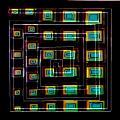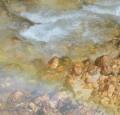DMT-Nexus member
Posts: 1 Joined: 07-Jun-2022 Last visit: 07-Jun-2022
|
Trichocereus terscheckii contains alpha-methyl-mescaline aka 345-Trimethoxy-Amphetamine (TMA) Browningia candelaris contains 4-Methoxyamphetamine (PMA) besides that these 2 cactus can produce substituted amphetamines, they share another unique trait in that they contain very high levels of N-di-methylated precursors. (whereas precursors in san pedro are relatively trace ie >0.01%). Tershcheckii containing high levels of di-methyl-mescaline (trichocerine) and browningia candelaris containing high fraction of N-dimethyl-4-methoxy-pea. I roughly calculate yield to be around 0.01% for alpha-methyl-mescaline and 0.03% for 4-Methoxyamphetamine (PMA). it seams the di-methylated pea's are direct precursors to these substituted amphetamines. the reaction is not elucidated yet but probably appears to be a 1-step reaction something like a phenylpropanoid-like imine methyl-transferase all-in-one. where one methyl is donated and the other relocating to alpha carbon. both san pedro and peyote contain trace quantities 0.01%> of hordenine and lobovine which are N-di-methylated pea's. It appears they dont exist in sufficient quantity at any given time to produce an amphetamine homolog at any detectable amount. Whether its due to insufficient N-methylation enzymes or oversufficient N-demthylation enzymes (probably both) they exist in low quantity. The methylation enzymes in cactus are very fast. Whereas Demethylations are slower (9:1) it seams completely plausible that san pedro and peyote could naturally produce alpha-methylations given the right (human intervention) circumstances, the products being MDA and Gepefrine. Why have I not seen this discussed anywhere else, this is an important discovery in my opinion that has profound implications in the organic/biochemical fields.  My image isnt loading but below link is an image showing gcms & relevant biosynthesis data I compiled https://i.ibb.co/Q9kgvHL/nm.png
|
|
|
|
|

DMT-Nexus member

Posts: 673 Joined: 04-Jul-2015 Last visit: 18-Feb-2025
|
My one experience with Terscheckii Tea resulted in me being amped up hard, peering out windows and even made me so paranoid I flushed a medium amount of cactus resin I'd put a lot of work into. It also contained mescaline, but whatever else was in it I would certainly describe as "amphetamine-like." This is the variety of Terscheckii I sampled. I believe it is referred to as "Golden Spine Terscheckii". Wolfnippletip attached the following image(s):  Cactus.21.7.9.BigTerscheckii.jpg (143kb) downloaded 247 time(s).My flesh moves, like liquid. My mind is cut loose.
|
|
|

Boundary condition

Posts: 8617 Joined: 30-Aug-2008 Last visit: 13-Nov-2025 Location: square root of minus one
|
That's an interesting find. The terscheckii paper can be found here: http://dx.doi.org/10.1111/bij.12036
Corio, C et al. April 2013: Biological Journal of the Linnean Society 109(2):342–353 "An alkaloid fraction extracted from the cactus Trichocereus terscheckii affects fitness in the cactophilic fly Drosophila buzzatii (Diptera: Drosophilidae)"The MS result doesn't entirely match the one published by Shulgin but there are a lot of overlaps which, along with the GC retention time, do give the claim some semblance of credibility (although for some reason I am reminded of the Clement et al. Acacia papers...) I'm still concerned by the lack of molecular ion at m/z 225 though. And just what is that huge peak at m/z 58? I suppose it is at 44+14, and instead of the molecular peak we see one at 225+14 = 239. So we're seeing a difference in ionization method (Shulgin used EI, these guys must have used CI which produced some ions with an extra (CH 2)+. fragment. Or was it N+. ? 14.037, or 14.05 even, seems rather heavy for CH 2. In the paper I couldn't find a direct mention of the ionization method used.) The Browningia reference seems to be here: https://www.researchgate...gia_candelaris_Cactaceae Echeverría, J. and Niemeyer, H.M.; July 2012: Boletin Latinoamericano y del Caribe de Plantas Medicinales y Aromaticas 11(4):341 - 344 "Phenylethylamines from Browningia candelaris (Cactaceae)" Here the identification of 4-methoxyamphetamine is hard to verify because they haven't included the MS spectrograms. “There is a way of manipulating matter and energy so as to produce what modern scientists call 'a field of force'. The field acts on the observer and puts him in a privileged position vis-à-vis the universe. From this position he has access to the realities which are ordinarily hidden from us by time and space, matter and energy. This is what we call the Great Work." ― Jacques Bergier, quoting Fulcanelli
|
|
|

Retired from Forum
Posts: 68 Joined: 16-Jul-2022 Last visit: 19-Jul-2022
|
How is alpha-methyl-N-Methyl-mescaline being distinguished from Trichocereine (NN-dimethyl-mescaline)?
Was there a comparison to proper samples of the alpha methyl and N methyl variations?
My understanding of this paper is that it lacked proper reference samples and could not offer a rational basis for the claim of alpha-methyl material.
That is to say my impression of the paper was that the author chose to extract known N methyl alkaloids and then propose them to be alpha methyl versions because of the difficulty of distinguishing them.
Deliberate and intentional fraud is what the paper seems to be.
What was the melting point of their purified extracted alpha-methyl-mescaline?
|
|
|

DMT-Nexus member
Posts: 14191 Joined: 19-Feb-2008 Last visit: 23-Oct-2025 Location: Jungle
|
Do you have the full paper? For some reason can' t get it with sci-hub... Thanks!
|
|
|

Retired from Forum
Posts: 68 Joined: 16-Jul-2022 Last visit: 19-Jul-2022
|
boop Here is the paper you asked for.
|
|
|

Retired from Forum
Posts: 68 Joined: 16-Jul-2022 Last visit: 19-Jul-2022
|
If Trichocereus species can contain amphetamines (alpha methyl PEAs) I consider that a very big deal.
I can easily be mistaken but I have the impression that N-methyl-mescaline and NN-dimethyl-mescaline are psychoactive stimulants rather than psychedelics and I thought that the alteration of activity from psychedelic to stimulant was a common result of adding a methyl-group to an amine.
Adding a methyl group to the alpha carbon of a psychedelic PEA alters it's pharmacology radically and profoundly. TMA variants of mescaline are highly psychedelic at 20mg, potentially 20 times stronger than mescaline.
I likely was too harsh in my assessment of fraud regarding the paper, however I consider the topic of San Pedro amphetamines to be controversial and unresolved.
|
|
|
DMT-Nexus member
Posts: 3 Joined: 29-Jan-2019 Last visit: 06-Aug-2024
|
Wolfnippletip wrote:My one experience with Terscheckii Tea resulted in me being amped up hard, peering out windows and even made me so paranoid I flushed a medium amount of cactus resin I'd put a lot of work into. It also contained mescaline, but whatever else was in it I would certainly describe as "amphetamine-like."
This is the variety of Terscheckii I sampled. I believe it is referred to as "Golden Spine Terscheckii".
My experience with T. terscheckii is just a dissocative state mixed with fever and memory loss. I've read that some think it contains tryptamines like NMT, but who really knows? Your Terscheckii looks like a terscheckii/werdermannianus hybrid. Nice!
|
|
|

Boundary condition

Posts: 8617 Joined: 30-Aug-2008 Last visit: 13-Nov-2025 Location: square root of minus one
|
Dahlby wrote:Wolfnippletip wrote:My one experience with Terscheckii Tea resulted in me being amped up hard, peering out windows and even made me so paranoid I flushed a medium amount of cactus resin I'd put a lot of work into. It also contained mescaline, but whatever else was in it I would certainly describe as "amphetamine-like."
This is the variety of Terscheckii I sampled. I believe it is referred to as "Golden Spine Terscheckii".
My experience with T. terscheckii is just a dissocative state mixed with fever and memory loss. I've read that some think it contains tryptamines like NMT, but who really knows? Your Terscheckii looks like a terscheckii/werdermannianus hybrid. Nice! This idea of tryptamines in Trichocereus species, whether this purported case of NMT in terscheckii or of DMT as mentioned by DP Henshaw is down to the reproduction of a typo in some ethnopharmacalogical work or other. It should have read "N-methyl tyramine". I have seen this error reproduced in several German-language works as well. As far as anyone knows, there are no tryptamines in any Trichocereus species. I think K. Trout will be able to confirm this, and if my recollection is not too hazy it is even covered in his work, "Cactus Alkaloids", or maybe "Cactus Chemistry by Species". E.g., K Trout wrote:N-Methyltyramine
Stimulant. S hulgin 1976
N-Methyl-4-hydroxyphenethylamine;
4-Hydroxy-N-methylphenethylamine; p-Hydroxyphenethyl
methylamine; 4-[2-(Methylamino)ethyl]phenol, 9CI ; NMT.
[It should be remembered that the abbreviation NMT is also used for
the alkaloid N-Methyltryptamine and the enzyme N-Methyltransferase.] “There is a way of manipulating matter and energy so as to produce what modern scientists call 'a field of force'. The field acts on the observer and puts him in a privileged position vis-à-vis the universe. From this position he has access to the realities which are ordinarily hidden from us by time and space, matter and energy. This is what we call the Great Work." ― Jacques Bergier, quoting Fulcanelli
|
|
|

In the gap between thoughts nonconceptual wisdom shines continuously.
Posts: 207 Joined: 16-Sep-2017 Last visit: 11-Mar-2024 Location: ⚗ alembic ⚗
|
|
|
|
DMT-Nexus member
  
Posts: 196 Joined: 15-Jan-2013 Last visit: 09-Feb-2024 Location: paradise
|
Dimethylmescaline has been reported to have some stimulant action. Same for other N-methylated phenethylamines.
Neither amphetamine that was reported from either cactus species was identified using reference standards or by isolation and structural elucidation. Instead they relied on compendiums of published spectra (which are great tools to narrow down the list of what is next looked at in greater detail but this approach commonly fails when it is employed as the sole means for identification).
Both of what were claimed to be amphetamines are far more likely likely to to be N-methylated rather than alpha-methylated. These can be easily confused in gcms unless a person uses a reference standard.
Notice in both papers that the n-methylated molecules are absent from the results despite the dimethylated compounds being present.
Just sayin'
|
|
|

Boundary condition

Posts: 8617 Joined: 30-Aug-2008 Last visit: 13-Nov-2025 Location: square root of minus one
|
Thanks for the further information, Keeper. Wolfnippletip wrote:My one experience with Terscheckii Tea resulted in me being amped up hard, peering out windows and even made me so paranoid I flushed a medium amount of cactus resin I'd put a lot of work into. It also contained mescaline, but whatever else was in it I would certainly describe as "amphetamine-like."
Bit of a tangent here, but we should prioritise testing of terscheckii using the CIELO method in order to see whether trichocerine (N,N-dimethylmescaline) is co-precipitated with mescaline. Shame you ditched that resin, Wolfie! “There is a way of manipulating matter and energy so as to produce what modern scientists call 'a field of force'. The field acts on the observer and puts him in a privileged position vis-à-vis the universe. From this position he has access to the realities which are ordinarily hidden from us by time and space, matter and energy. This is what we call the Great Work." ― Jacques Bergier, quoting Fulcanelli
|
|
|

❤️🔥
 
Posts: 3648 Joined: 11-Mar-2017 Last visit: 02-Jun-2025 Location: 🌎
|
downwardsfromzero wrote:Thanks for the further information, Keeper. Wolfnippletip wrote:My one experience with Terscheckii Tea resulted in me being amped up hard, peering out windows and even made me so paranoid I flushed a medium amount of cactus resin I'd put a lot of work into. It also contained mescaline, but whatever else was in it I would certainly describe as "amphetamine-like."
Bit of a tangent here, but we should prioritise testing of terscheckii using the CIELO method in order to see whether trichocerine (N,N-dimethylmescaline) is co-precipitated with mescaline. Shame you ditched that resin, Wolfie! We have early CIELO Terscheckii results from member navegandouniversos. A xtaline powder formed salting with fumaric. Posting here in case someone comes someone comes across this thread first.
|